
Washington's Headquarters State Historic Site, also called Hasbrouck House, is located in Newburgh, New York, United States, overlooking the Hudson River. George Washington lived there while he was in command of the Continental Army during the final year of the American Revolutionary War; it had the longest tenure as his headquarters of any place he had used.
Hasbrouck House may refer to:
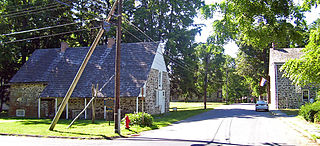
Historic Huguenot Street is located in New Paltz, New York, approximately 90 miles (140 km) north of New York City. The seven stone houses and several accompanying structures in the 10-acre National Landmark Historic District were likely built in the early 18th century by Huguenot settlers fleeing discrimination and religious persecution in France and what's now southern Belgium. After negotiating with the Esopus Indians, this small group of Huguenots settled on a flat rise on the banks of the Wallkill River in 1678. The settlers named the site in honor of Die Pfalz, the region of present-day Germany that had provided them temporary refuge before they came to America. Archaeological finds indicate that the immediate area settled by the Huguenots was occupied by Native Americans prior to European contact. The site is one of the oldest continuously inhabited settlements in the United States.
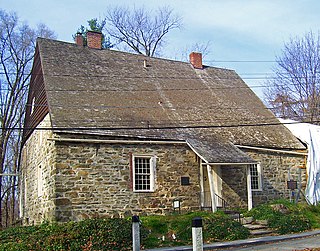
The Jean Hasbrouck House is a historic house on Historic Huguenot Street in New Paltz, New York. Built in 1721, it is one of the best examples of colonial Dutch architecture in stone in the United States. The house is a National Historic Landmark and is part of the larger Huguenot Street Historic District, also a National Historic Landmark.

Locust Lawn is a surviving 19th-century farm complex situated on the bank of the Plattekill Creek on New York State Route 32, outside of New Paltz, Ulster County, New York.

The Major Jacob Hasbrouck Jr. House is located on Huguenot Street in the Town of New Paltz, New York, United States. It was built in 1786 by Hasbrouck, grandson of Jean Hasbrouck, one of the original Huguenot settlers of the New Paltz area in the late 17th century, after he had moved out of the family home, two miles (3.2 km) to the south in what is today the Huguenot Street Historic District. A descendant of his lives in the house today, and it is believed to be the only 18th-century stone house in the New Paltz area continuously owned by the family that first built it.

New Paltz is a village in Ulster County located in the U.S. state of New York. It is approximately 80 miles (130 km) north of New York City and 70 miles (110 km) south of Albany. The population was 7,324 at the 2020 census.
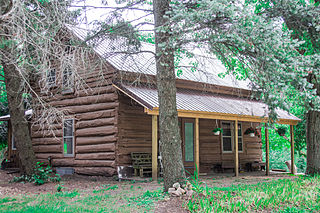
The Jared H. Gay House is a log house located Route 2, 128th Avenue, in Crystal Valley, Michigan. It was designated a Michigan State Historic Site in 1987 and listed on the National Register of Historic Places in 1989.

The Dougherty Mission House is a house located at 18459 Mission Road in Peninsula Township, Michigan. It was designated a Michigan State Historic Site in 1956 and listed on the National Register of Historic Places in 2011. The house was certainly one of the first frame buildings constructed in Grand Traverse County, and is thought to be the first post and beam house constructed in Michigan's lower peninsula north of Grand Rapids.
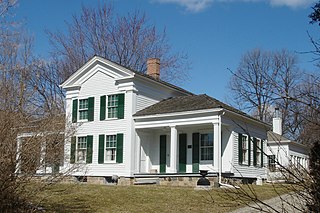
The Royal Aldrich House is a single-family house located at 31110 West 11 Mile Road in Farmington Hills, Michigan. It was listed on the National Register of Historic Places in 1994. It is one of a few remaining Greek Revival style houses in southeast Michigan still located on the site where built.

The Eli and Sidney Teeter Albertson House is a single family home located at 4480 Sheldon Road in Oakland Charter Township, Michigan. It is a rare Victorian example of an I-house in Oakland Township. It was listed on the National Register of Historic Places in 2002.
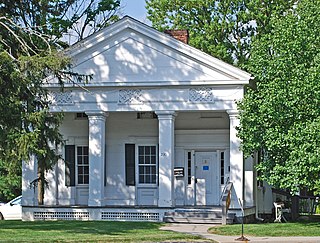
The William Anderson House is a single-family home located at 2301 Packard Road in Ann Arbor, Michigan. It was listed on the National Register of Historic Places in 1983.

The Bell-Spalding House, also known as the Tuomy House, is a single-family home located at 2117 Washtenaw Avenue in Ann Arbor, Michigan. It was listed on the National Register of Historic Places in 1990.

The Kellogg-Warden House is a single-family house located at 500 North Main Street in Ann Arbor, Michigan. It was listed on the National Register of Historic Places in 1994. It now houses the Washtenaw County Historical Society's Museum on Main Street.

The George Louk Farm is a rural farmstead located at 1885 Tooley Road near Howell, Michigan. It was listed on the National Register of Historic Places in 1995.

The Williams-Cole House is a single family home located at 6810 Newburg Road near Durand, Michigan. It was listed on the National Register of Historic Places in 1986.
The Frederick A., Jr. and Caroline Hewett Kennedy Farm is a historic farmstead located at 8490 Hanover Road near Hanover, Michigan. It was listed on the National Register of Historic Places in 2000.

The Booth-Dunham Estate is a single-family home located at 6059 South Ninth Street Texas Charter Township near Kalamazoo, Michigan. It was listed on the National Register of Historic Places in 1998.

The Benjamin and Maria (Ogden) Drake Farm, also known as the Drake Farmstead, is a farmstead located at 927 North Drake Road in Kalamazoo, Michigan. It was listed on the National Register of Historic Places in 2012, and as of 2021 is open to the public as the Drake Farmstead Park.
The Hasbrouck family was an early immigrant family to Ulster County, New York, and helped found New Paltz, New York. The Hasbrouck family were French Huguenots who fled persecution in France by moving to Germany, and then the United States. Two brothers, Jean II and Abraham, are the ancestors of almost all individuals in the United States with the last name "Hasbrouck," or some variation.




















